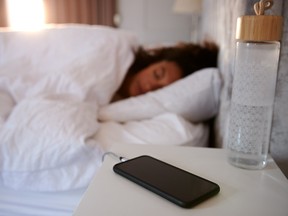The batteries can catch fire by overheating, which triggers a “thermal runaway” — a chain reaction that leads to fast-spreading flames.

Article content
A top Montreal fire official is urging people to rethink a common habit: charging devices like iPhones and tablets overnight while they sleep.
The advice comes after a fire at the Port of Montreal on Monday, fueled by 15,000 kilograms of lithium-ion batteries — the equivalent of more than 200 Tesla cars. Firefighters battled through the night to extinguish the blaze, which prompted the evacuation of around 100 residents and a temporary lockdown for others nearby. The fire department is investigating the cause of the fire.
Advertisement 2
Story continues below
Article content
It wasn’t an isolated incident, said Matthew Griffith, section chief of prevention for the Montreal fire department. So far in 2024, the Montreal Island has recorded 40 fires related to lithium-ion batteries. That number was just seven a few years ago, he said.
Griffith attributed the rise to the growing use of the batteries, which are found in everything from smartphones to tablets to e-scooters, and said damaged devices significantly increase the risk of fire.
The batteries can catch fire by overheating, which triggers a phenomenon known as thermal runaway — a rapid chain reaction that leads to fast-spreading flames.
“These battery fires are tough to put out,” said Montreal fire department division chief Martin Guilbault, speaking from the scene of Monday’s fire. “The only way to extinguish them is to douse the batteries with water to cool them down and stop the chain reaction.”
Beyond the immediate fire risk, these incidents also release harmful pollutants like hydrogen fluoride and fine particulate matter (PM2.5), which can enter the lungs and bloodstream.
Article content
Advertisement 3
Story continues below
Article content
“Exposure to very high levels of hydrogen fluoride can cause chemical burns, eye irritation and respiratory distress,” said Jill Baumgartner, a McGill University professor researching epidemiology and occupational health.
“Acute exposure to PM2.5 can trigger a range of health effects, from throat or airway irritation to worsening asthma and an increased risk of heart attacks and strokes, particularly in vulnerable populations like children, the elderly, and those with pre-existing conditions,” she said.
Fortunately, the fire at the Port was in an isolated container, preventing the fire from spreading to other cargo or nearby residential areas. Griffith noted that one firefighter was injured and that once Environment Canada confirmed the air quality was safe, the lockdown notice was lifted.
Griffith has five safety recommendations for Montrealers:
- Use the correct charger for your device, such as the one that comes with the device.
- Replace aging batteries.
- Avoid cheap, uncertified batteries bought online.
- Charge devices only while awake and with the device on a hard surface — not on beds or couches.
- Ensure working smoke alarms are installed on every floor of your home.
Advertisement 4
Story continues below
Article content
Charging a device with a lithium-ion battery longer than the necessary time it needs is a major cause of damaging the device.

“I know many people charge their phones overnight — putting them on the nightstand before bed — but we recommend folks get in the habit of doing it while they’re awake,” he said. “That way, if something happens, you’re alert and can detect it quickly.”
Jason Reid, senior adviser at the National Life Safety Group, a fire and safety advisory group operating across Canada, emphasized the importance of following manufacturers’ guidelines and avoiding the use of damaged batteries.
He highlighted the risks associated with uncertified or modified devices and warned that safety regulations haven’t kept pace with the widespread adoption of lithium-ion technology. While municipalities have been proactive, he said, there’s still a need for more public education and clearer terminology.
“This technology is becoming standard in every home and community, and the standards and regulations simply haven’t kept up.”
He added, “I’m aware of three fatal fires where people charged an e-bike or e-scooter at their front door, and when the fire started, they couldn’t escape their home.”
Griffith emphasized that the fires are not limited to Montreal, but are seen across Canada and internationally. With more devices relying on lithium-ion technology, and the ever-growing demand for smaller, faster, more powerful batteries, it’s a concern all fire departments are addressing.
Recommended from Editorial
Advertisement 5
Story continues below
Article content
Article content


Comments